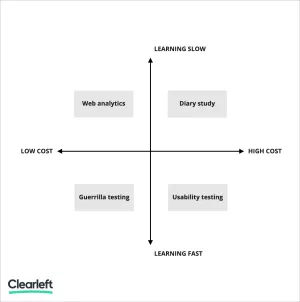- Viewpoint
For some, guerrilla testing is a dirty word. A victim of its own success, its overuse has given it a bad rap. Thanks to the ever-growing research community ReOps, research is gaining more room at the table. Isn’t it about time we celebrated the strengths of guerrilla testing?
What is guerrilla testing?
Guerrilla testing is a low-cost method that helps you quickly answer straightforward research questions. It forces you out of the office and gets you face-to-face with the general public for a short but valuable amount of time.
Guerrilla testing differs from more structured and in-depth research methods in a number of ways.
In-depth listening sessions and usability testing go deep to uncover rich and nuanced insights. They need a dedicated period of time for recruitment. We qualify potential applicants against strict audience criteria. This ensures those involved in the research reflect the motivations and needs of the wider audience.
In comparison, guerrilla testing is shallower in its depth of insight. It shortcuts the recruitment process by using members of the public. Even with this tradeoff, we still want people to be as representative of the audience as possible, so a little more thought and effort is needed to find them.
Longitudinal and ethnographic methods such as diary studies can span weeks or months. We use these methods to understand the bigger picture of people’s lives and the extent to which products and services support them. However, when our research questions are smaller in scope and we need answers quickly, we can use guerrilla testing to receive answers within hours or days rather than weeks or months.
More in-depth and longer research studies also come at a financial cost. Alongside time, the cost is one of the most common barriers to conducting research with customers. But it needn't be. Guerrilla testing is inexpensive to set up and run. When used properly it’s far better than no research at all.

Guerrilla testing offers a handful of benefits, especially for those organisations that have yet to adopt research as part of their design process. Guerrilla testing…
- Enables teams to break out of the cycle of debating assumptions and into the context of their customers,
- Introduces the value of customer insight for research-immature organisations,
- Alleviates the anxieties of time and cost for research sceptics,
- Helps to move designs more quickly through the decision process,
- Offers a low friction way of quickly answering questions and avoiding decision making paralysis and stalemates.
When to use guerrilla testing and why
At Clearleft, we use three distinct flavours of guerrilla testing; intercept interviews, prototype testing, and light-touch ethnography.
Intercept interviews
With intercept testing we approach people in the context of their task and ask them to answer a few questions. To increase our chances of a successful intercept, contexts and tasks should be low-risk. Participants browsing a selection of supermarket jams takes far less mental effort than operating complex equipment. Armed with a handful of snappy questions, we can include a quick design exercise like the 20-second gut test. Intercepts should last 10-15 minutes. As with all research, we believe it is good practice to offer a token of appreciation. A £5 gift voucher is more than enough.
We used intercept interviews to understand how people respond to product propositions for a well known tech startup. Over the course of the project we spoke to 16 people.
Prototype testing
Prototype testing is a pared-back usability test. It’s used to identify a small number of usability issues. The maturity of the prototype shouldn’t prevent you from testing: paper sketches, clickable wireframes, existing websites and native apps are all acceptable. This task-based test lasts around 10-15 minutes. Again, offer a gesture of thanks for people’s time.
We used prototype testing to quickly and cheaply test early design concepts for Virgin Holidays. We spoke to 10 people in total but started seeing patterns after 5 tests.
Light-touch ethnography
Light-touch ethnography combines insight from environment-focused research methods. Methods include competitive testing and unobtrusive measures (learning through physical traces and indirect participant observation). They help us to understand what people are using and the environments in which they use them. We get out of the office, we step into our audience’s shoes, and we gain an immersive empathic first-hand experience.
We used light-touch ethnography to quickly understand the range of touchpoints customers would engage with for a well known retail giant.

Real-world examples
Here are a few real-world examples of when we’ve decided to use guerrilla testing or not:
Appropriate
- Understanding what parts of a UI support and hinder a search journey.
- Understanding if people can successfully complete a bookmarking journey.
Inappropriate
- Understanding the end-to-end process of long-haul holiday planning.
- Understanding how people plan and shop for groceries over time.
Guerrilla testing will help you quickly answer a handful of questions at a low cost but it’s not enough to form a business strategy.
Go forth and learn
To learn at the required speed and depth we need a range of methods at our disposal. When time and budget are working against you, reach for a method like guerrilla testing that allows you to make the progress you need.
This post was originally published on my own website
Related thinking
- Viewpoint
Recruiting for UX research
- Viewpoint


